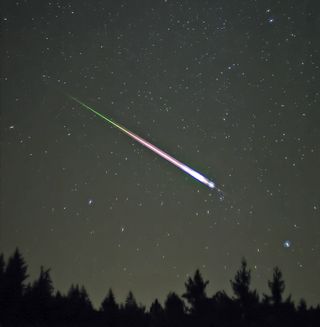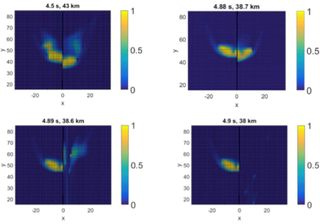In Earth's Atmosphere, Meteors May Explode from the Inside Out

Meteors explode from the inside out as they plunge through Earth's atmosphere, new research shows.
Using computer simulations, the authors of a new research paper show that gases in Earth's atmosphere may infiltrate the interior of porous meteors as they hurtle toward the planet, creating pockets of high-pressure air inside the rocky space debris. These pockets can then cause the space rocks to explode, breaking into smaller pieces. This could be a benefit for life-forms on Earth, because it means fewer large meteors survive long enough to impact Earth's surface, the researchers said.
"There's more going on than what had been thought before," Jay Melosh, a geophysicist at Purdue University in Indiana and one of the study authors, said in a statement. "Bottom line is that the atmosphere is a better screen against small impacts than we had thought." [Astronaut Snaps Stunning Meteor Pictures from Space]
Melosh presented the findings Dec. 11 at the 2017 American Geophysical Union (AGU) Fall Meeting in New Orleans.
An estimated 44,000 kilograms (97,000 lbs., or 48.5 tons) of meteoritic matter lands on Earth every day, according to a statement from the AGU. When meteors enter the planet's atmosphere, they heat up, and ultimately disintegrate. (This is either because of something -called ram pressure or friction.). However, the new research highlights a new way in which the atmosphere may break up meteors and protect Earth, the researchers said.
In the study, the researchers simulated the meteor that exploded over Chelyabinsk, Russia,on Feb. 15, 2013. The 20-meter (65 feet) rock exploded 18.5 miles (29.7 kilometers) above Earth's surface, damaging buildings and injuring more than 1,000 people.
Using the simulations, the researchers aimed to better understand how the Chelyabinsk meteor broke apart and disintegrated as it entered Earth's atmosphere. Unlike earlier models, however, the new simulations factored in the porosity of the meteor, according to the statement.
Get the Space.com Newsletter
Breaking space news, the latest updates on rocket launches, skywatching events and more!

The results showed that Earth's atmosphere provides better protection against meteors than scientists previously thought, by creating a dense pocket of air in front of the rockand a vacuum in the meteor's wake.
As a result, "the pressurized air bubble ahead of the meteor is strongly attracted to the low-pressure environment developing behind the meteor, causing air particles to rapidly flow through the rock's cracks and holes from the front to the back of the rock," according to the statement.
The high-pressure air that is forced into the nooks and crannies of the meteor breaks up the space rock in Earth's upper atmosphere, the researchers said.
The findings were published Dec. 11 in the journal Meteoritics & Planetary Science.
Follow Samantha Mathewson @Sam_Ashley13. Follow us @Spacedotcom, Facebook and Google+. Original article on Space.com.
Join our Space Forums to keep talking space on the latest missions, night sky and more! And if you have a news tip, correction or comment, let us know at: community@space.com.

Samantha Mathewson joined Space.com as an intern in the summer of 2016. She received a B.A. in Journalism and Environmental Science at the University of New Haven, in Connecticut. Previously, her work has been published in Nature World News. When not writing or reading about science, Samantha enjoys traveling to new places and taking photos! You can follow her on Twitter @Sam_Ashley13.
